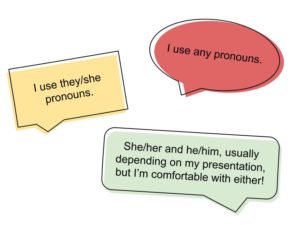By Ace Garrett
Right now as you read, gender is evolving into the fun, expressive, and validating construct that it always should have been. People here in America finally have the language to understand and express their gender, and many are beginning to step outside of traditional gender expectations and live as their most authentic selves—which is all any of us want, right? If you want to continue being supportive of gender non‑conforming people, a good place to start is understanding pronouns.
This week, Sierra skillfully informed us about pronouns and their independence from gender, which I am following up with this little series of additions to help you understand the niche aspects of pronouns and gender. Today, we’ll be covering the use of multiple pronouns.
You might be surprised, but many people actually use multiple sets of pronouns. For some, a mixture of pronouns might best reflect them. For others, they might simply be comfortable with more than one set and allow their friends and family to choose whichever they want to use. There are some people that are even comfortable using any pronouns!

You probably know that pronouns come in sets of three (e.g., she/her/hers), but all three parts is pretty redundant, so pronouns have already been commonly abbreviated to the first two parts: she/her; they/them; he/him; etc. And these sets get abbreviated even more when someone uses multiple pronouns. People who are comfortable with more than one set of pronoun often abbreviate their pronouns like this:
- she/they
- they/he
- he/they/she
For some, this represents a catalogue of the pronouns they are comfortable with. However, some people have a preference, and they will put the pronoun set they are most comfortable with at the beginning. For example, non‑binary people who prefer they/them pronouns may also be comfortable with the pronouns tied to their sex assigned at birth—especially if (1) they are just discovering their gender identity or (2) they present in a very feminine or masculine way.
But remember what Sierra covered on Monday: pronouns and gender are independent parts of our identity, which is also independent from gender presentation. Someone could, for example, present very feminine while only using they/them pronouns and being agender.
To wrap this post up, I want to remind you that all people are different. We don’t have labels and “rules” in order to box people in; we have them to help people express themselves and find community. Each person is an authority over their own identity, and we should all take care to listen and be open to people falling outside our expectations.
Keep an eye out for part two!